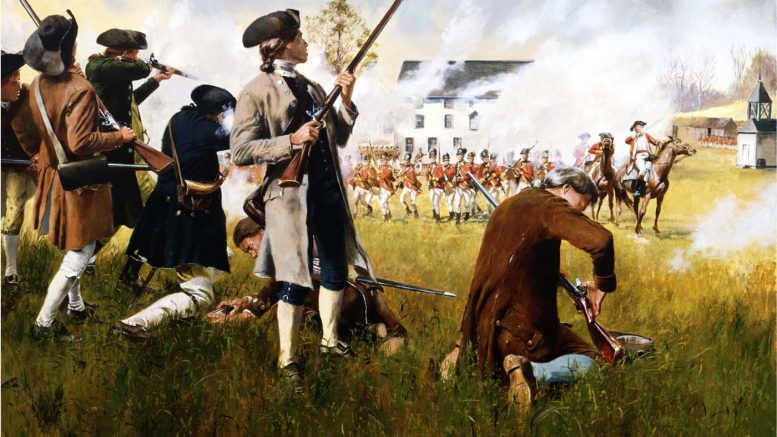Back-to-back World War champs and arguably the strongest military in the world, America’s Soldiers have carried a wide array of rifles in the past 244 years.
Colonial origins
Going as far back as the matchlocks carried by settlers at Sir Walter Raleigh’s short-lived Lane Colony in 1585, America had a gun culture. According to early militia laws established in the 17th Century, able-bodied men in the colonies had to keep “a good musket or firelock, or rifle, knapsack, shot pouch and powder horn” at hand to use in their role in the common defense.
By 1775, at the outbreak of the War of Independence that would see the original 13 Colonies sever their relationship with the British throne, each community had its local militia force. It was such as the force that met the King’s men at Lexington and Concord on that fateful day that sparked the American Revolution, and the citizen-soldiers were armed with a variety of “fowling pieces”– early muzzleloading shotguns– Pennsylvania rifles, and a surplus military arms such as French M1728 and British Pattern muskets.
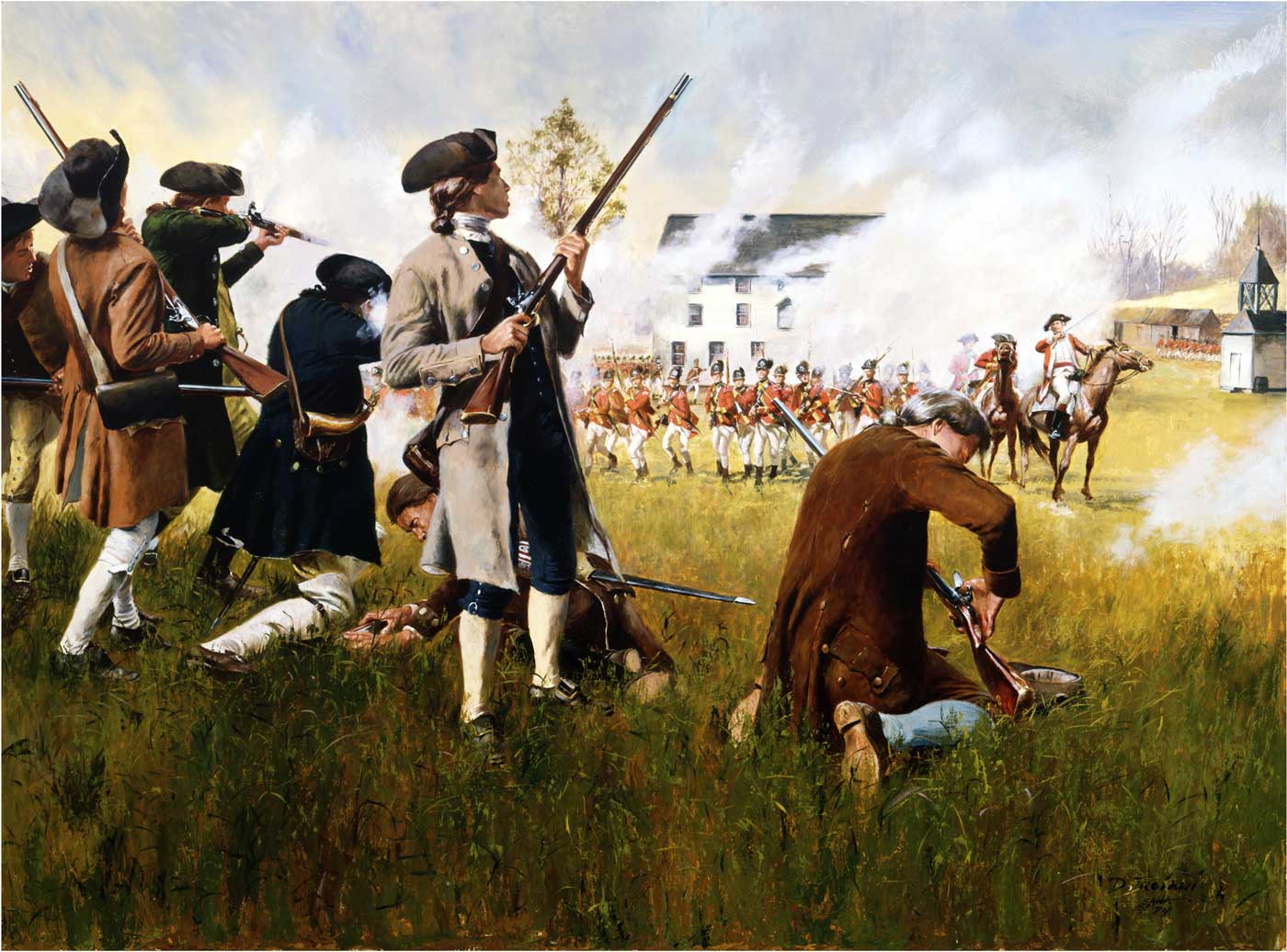
“Stand Your Ground” by Don Troiani, portraying the 77 volunteers, aged 18 to 63, of Captain John Parker’s company of militia that met the 700-strong British force on April 19, 1775. (Photo: U.S. National Guard)
It was these sorts of guns that formed the Colonial Army with the Continental Congress deciding on June 14, 1775, to establish a force of “six companies of expert riflemen” drawn from throughout the colonies. Today the U.S. Army cites that day as its birthday.
Moving past those initial guns, the growing force under Gen. George Washington became more professional and used a mix of then-modern military arms such as the British Sea Service or Commercial Contract Long Land “Brown Bess” musket and French-supplied Charleville muskets.
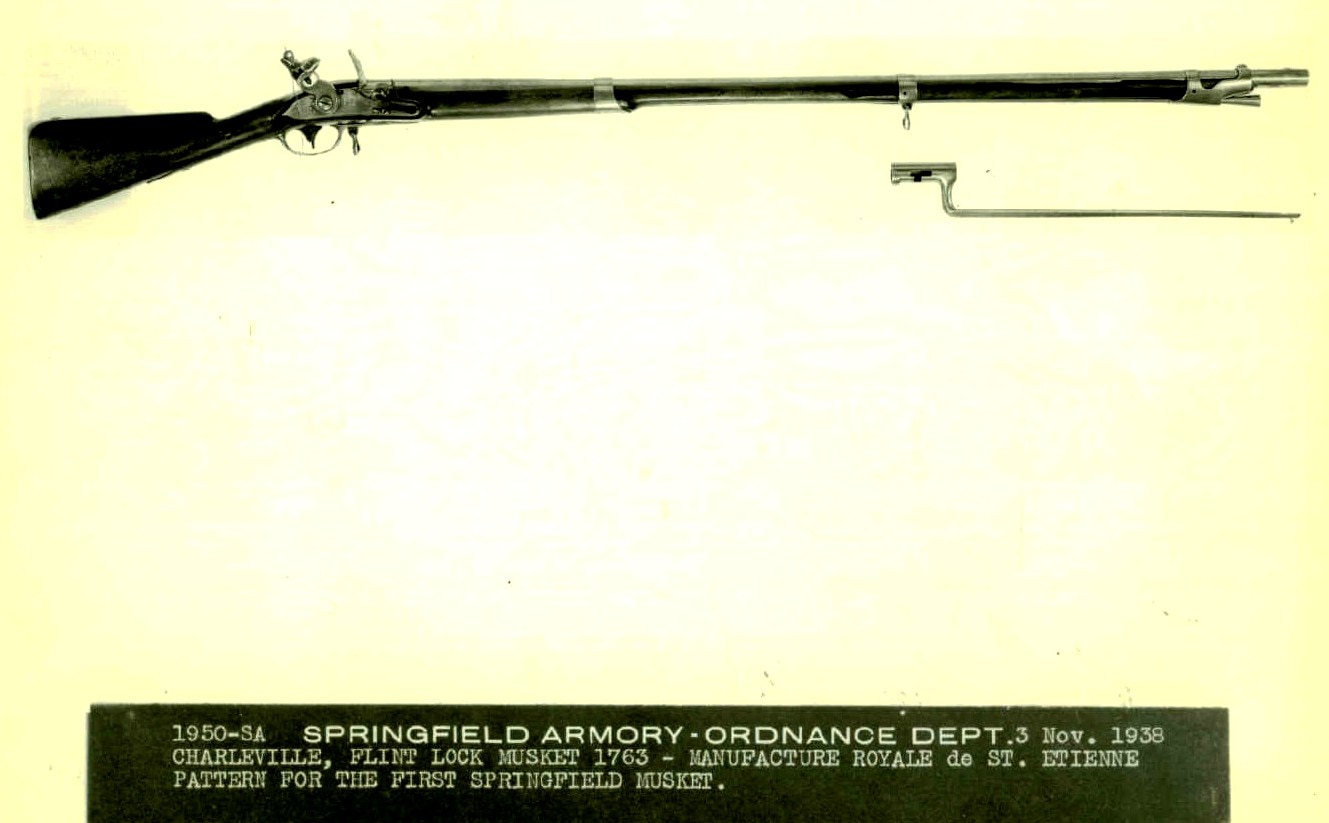
Charleville flintlock musket produced at the Royale de St. Etienne Arsenal. The Springfield Model 1795 musket was based on the design. (Photo: Springfield Armory National Historic Site)
Modern tests on French and British military muskets of the Revolutionary War period show that the .662- and .69-caliber spherical lead balls of the day could penetrate a superb 32-inches of modern ballistics gel at close range (25 yards) but would rapidly slope and, at ranges of anything over 150 yards, hit the ground.
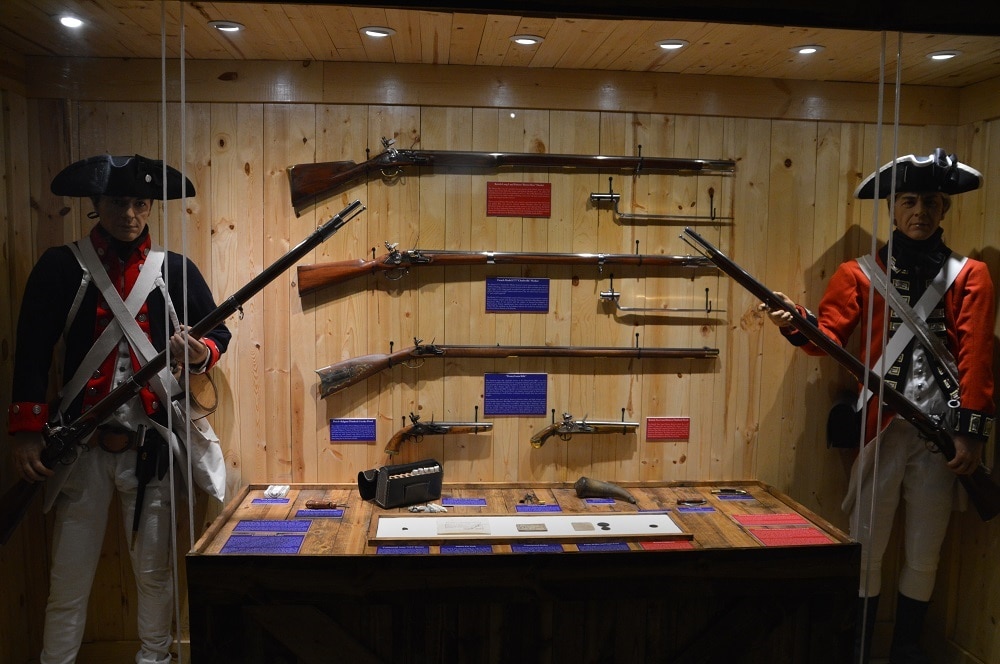
Revolutionary War weapons such as British Brown Bess and French 1777 Charleville muskets, top, along with their bayonets, and a Pennsylvania rifle on display at the Indian State Military Museum. Note the power horn and cartridge pouch. (Photo: Chris Eger/Guns.com)

Today at least one active-duty element of the U.S. Army– the Old Guard’s Commander-in-Chief’s Guard– still carries Brown Bess flintlocks. (Photo: U.S. Army)
Past Yorktown
Established by George Washington in 1777 to make artillery carriages, the Springfield Armory as it became known, made the nation’s first muskets in 1795.
Based on the design of the French Charleville, the Springfield was a 10-pound smoothbore flintlock with a 42-inch barrel and an overall length of five feet. With the 16-inch long spike bayonet fitted to the end of the musket, it stood taller than the men who carried it. Firing a .69-caliber ball it was accurate only to about 75-yards but could still cause damage 100 yards away making the gun more of a volley than a precision (or even accurate) weapon.
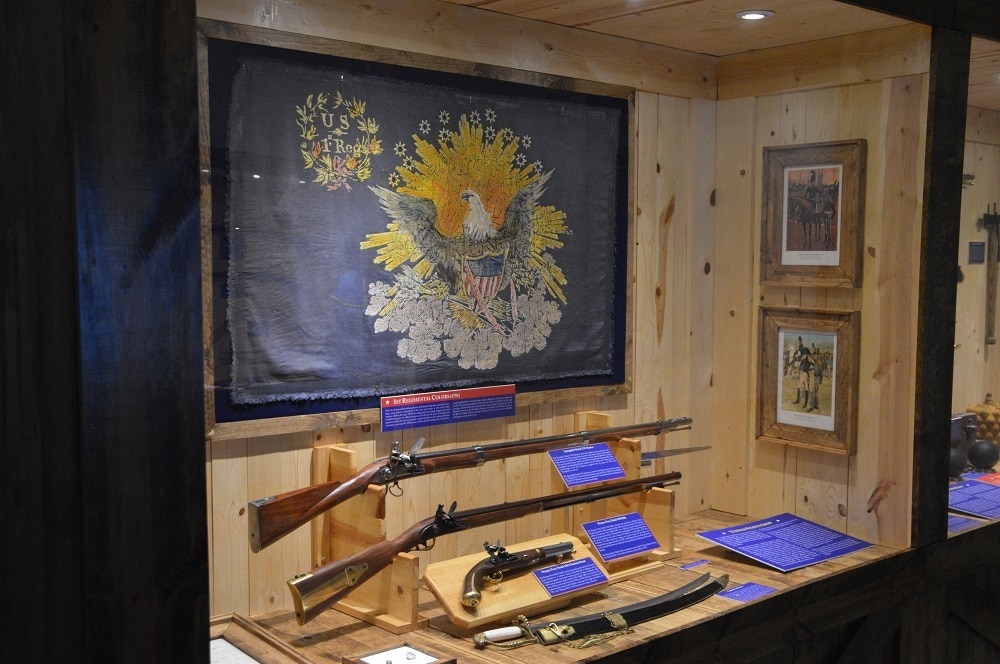
Moving past the M1795, the Model 1801 Haper’s Ferry Rifle was both downright handy and accurate, with a 33-inch long .54-caliber octagon barrel firing a small (for the time) .525-caliber ball. These proved effective in the War of 1812. The M1795 is on top in the above display, with the shorter M1801 below it. (Photo: Chris Eger)
19th Century innovation
Throughout the 1800s, small arms technology rapidly matured and the U.S. Army had to update their rifles regularly to keep ahead of the curve.
By 1819, the .54-caliber Springfield flintlock was adopted.
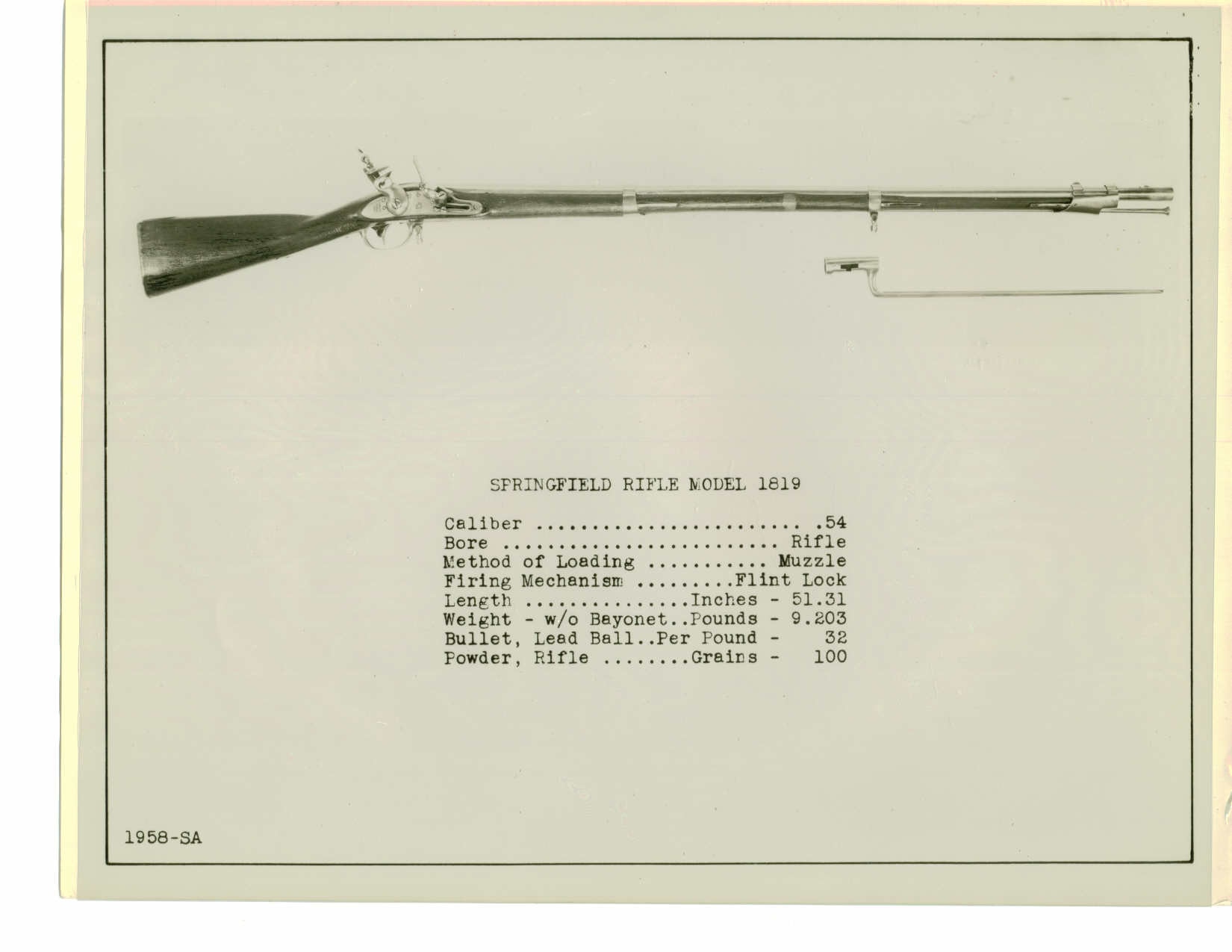
(Photo: Springfield Armory National Historic Site)
In 1842, the Army moved from flintlocks to more reliable percussion cap-fired rifles, with more than 170,000 produced.
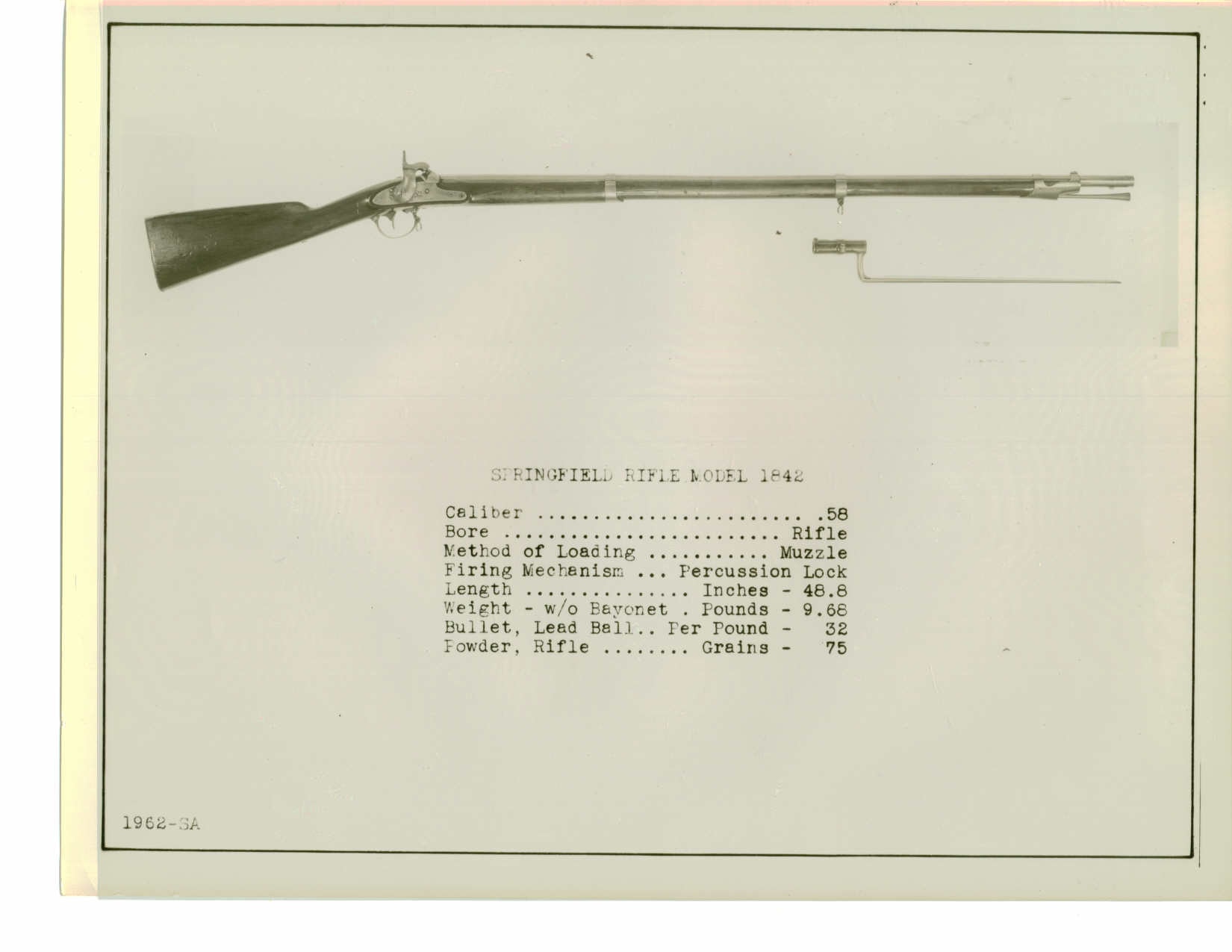
(Photo: Springfield Armory National Historic Site)
In 1855, the .58-caliber Springfield rifle was the new standard, able to use the devastating Minié ball. Using the interesting but ultimately unsuccessful Maynard tape primer, it was replaced by the tried and true percussion cap lock in the Model of 1861, a design that was tweaked throughout the Civil War in the follow on models M1863, M1864, and so forth.
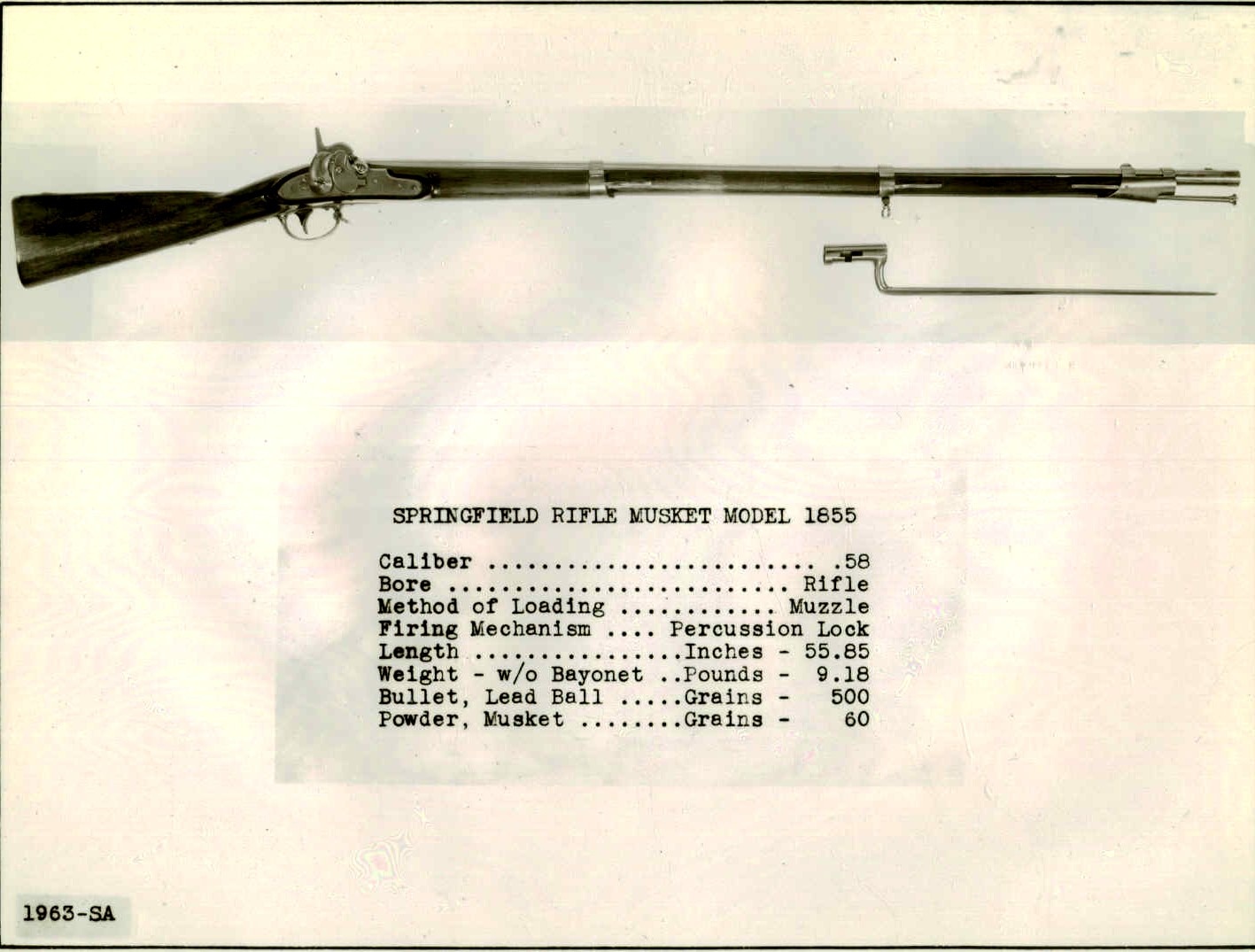
(Photo: Springfield Armory National Historic Site)
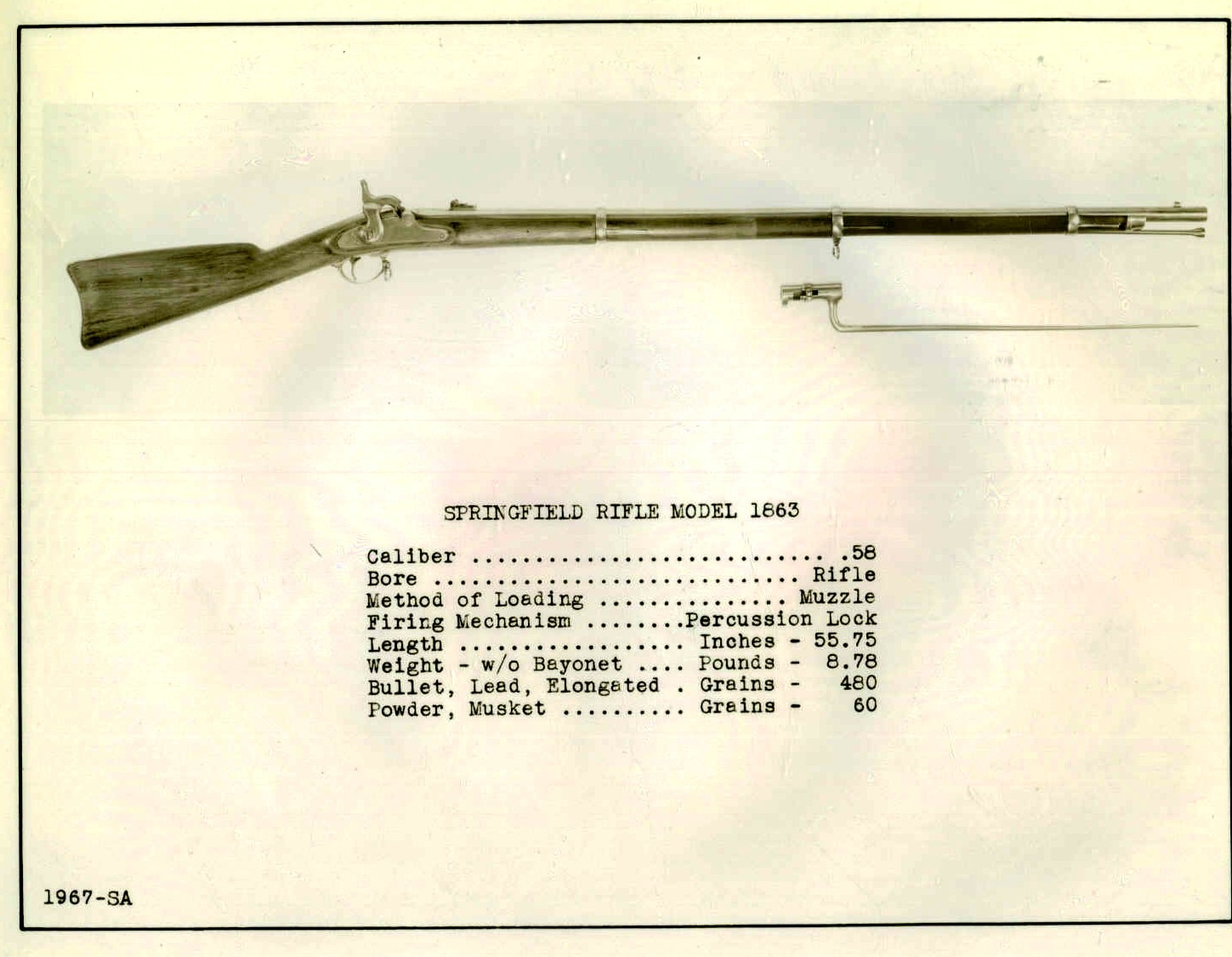
(Photo: Springfield Armory National Historic Site)
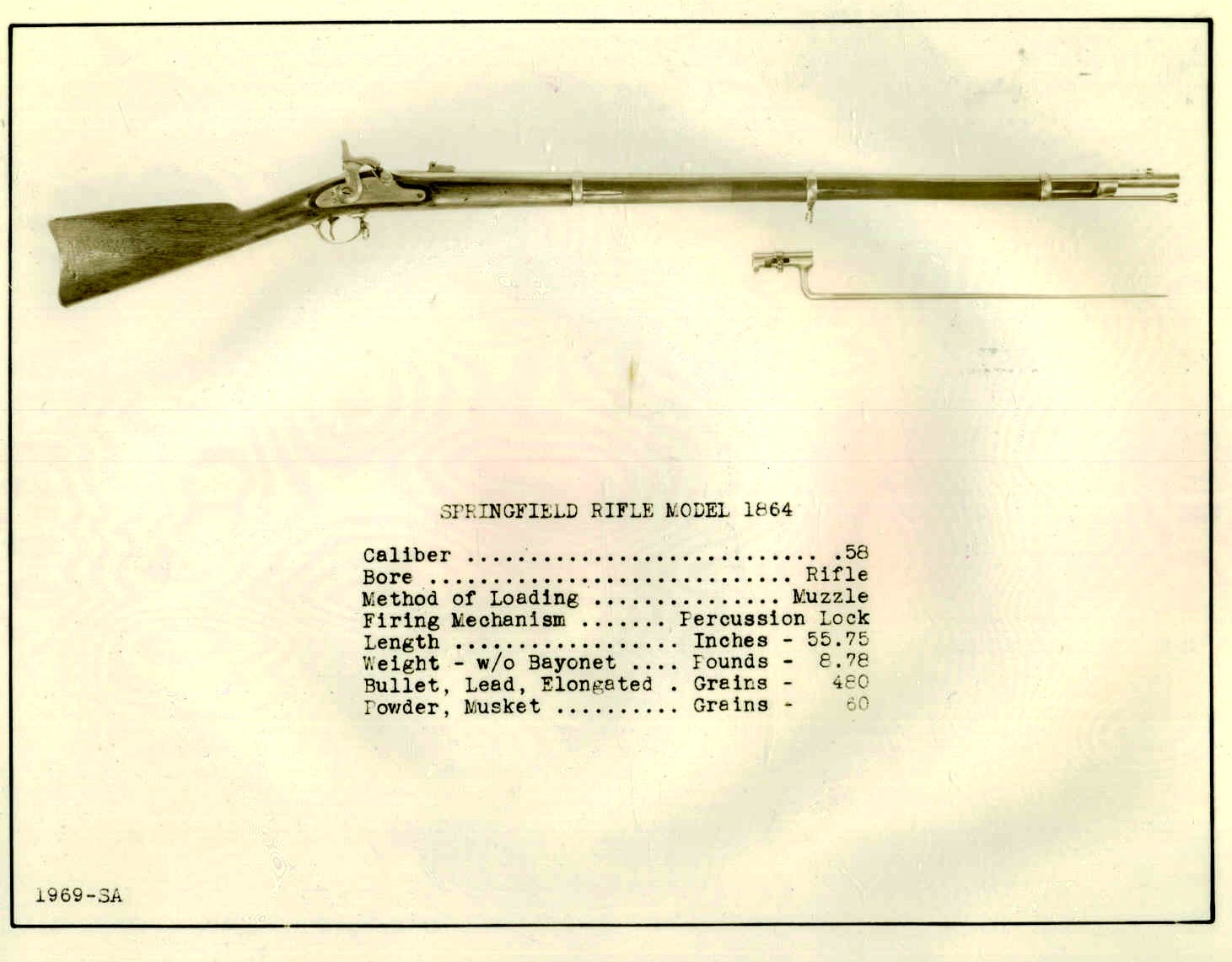
(Photo: Springfield Armory National Historic Site)
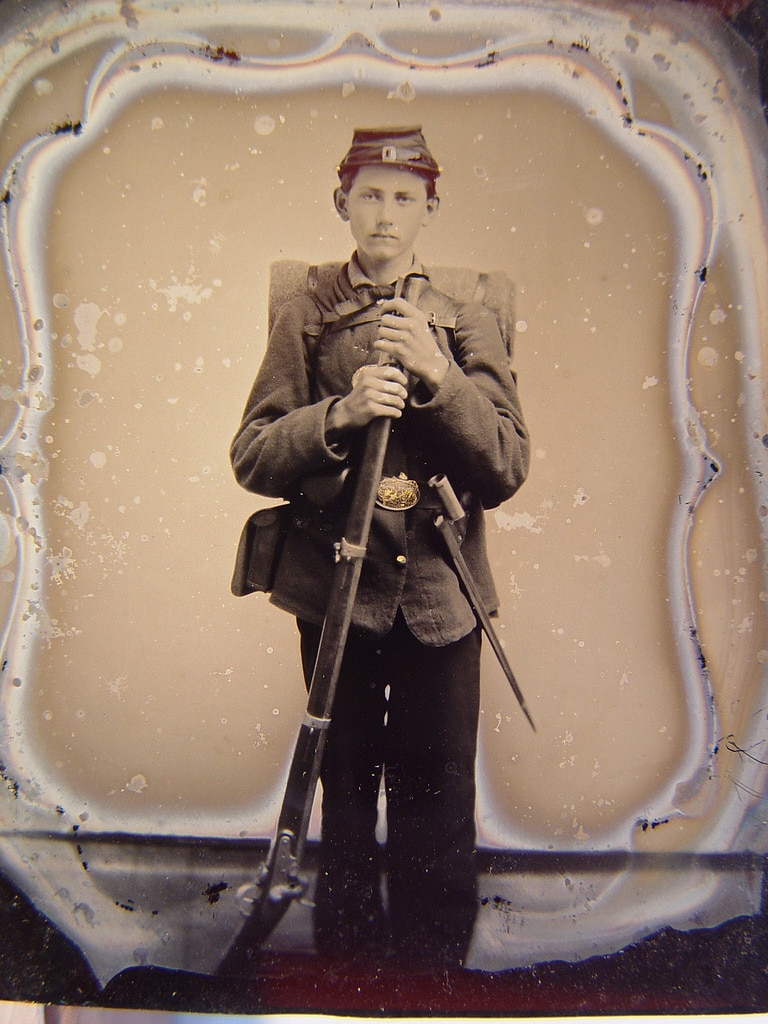
“Unidentified young soldier in Union uniform with musket, bayonet, and knapsack.” While most of the more than 2 million Union Soldiers in the Civil War carried Springfield rifled muskets, the U.S. also imported thousands of muskets from Europe as well. (Photo & quoted caption: Library of Congress)
Just after the Civil War, the M1866 .50-caliber rifle was the latest development, moving to breechloading cartridges. This began the era of “Trapdoor” single-shot cartridge rifles than continued to be used as late as 1898.

(Photo: Springfield Armory National Historic Site)
By 1884, guns like the Ward-Burton, a turn-bolt-action magazine-fed rifle, were the new normal.
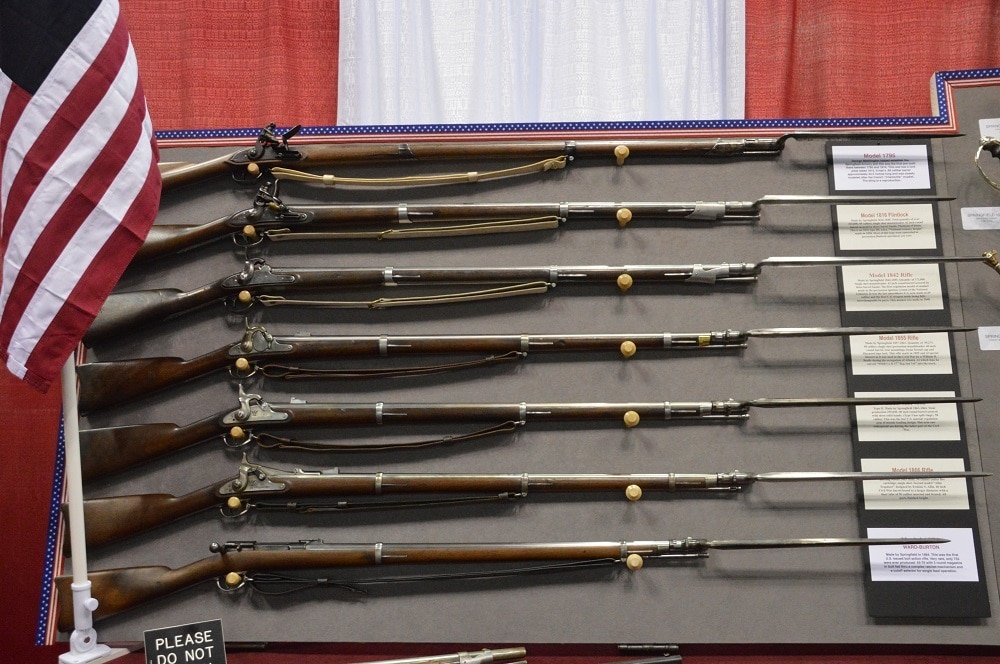
This display by the Springfield Collector’s Association in 2019 has an M1795 at the top, followed by an M1816 .69-caliber flintlock, M1842 .42-caliber percussion rifle, two M1855 .58-caliber muzzleloading rifles, an M1866 .50-caliber breechloading rifle and a bolt-action Ward Burton magazine rifle in .45-70. (Photo: Chris Eger).
At the close of the 19th Century, the Army had been issuing various models of the .30-caliber Krag rifle, a Scandanavian design with an unusual side-loading magazine.
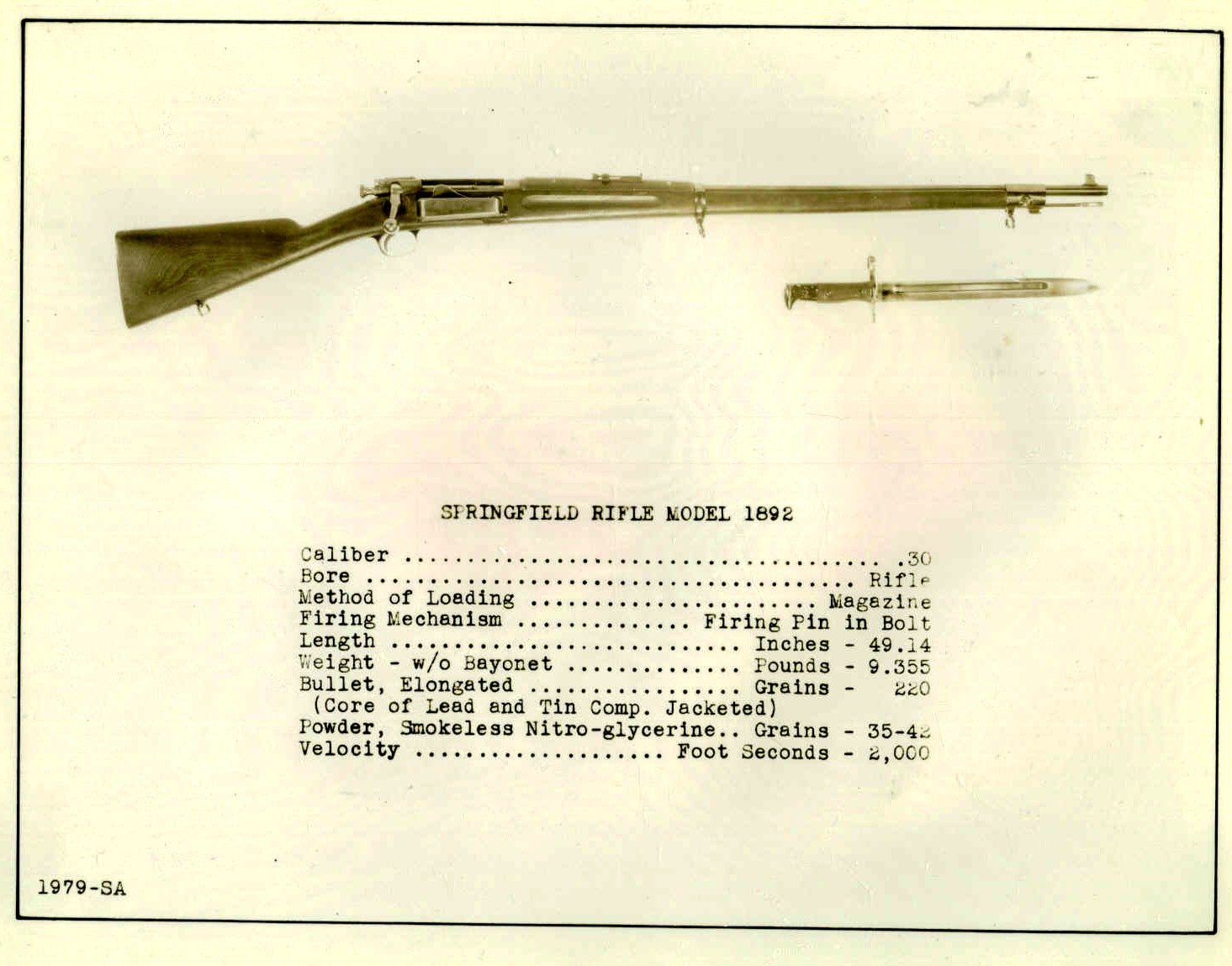
The Krag. These are increasingly hard to find in original condition, being extensively converted to “sporters” in the 1900s. (Photo: Springfield Armory National Historic Site)

U.S. Soldiers would carry the Krag, seen to the left, into battle in the Spanish-American War and Philipines insurrection, where during the former it was stacked against Mauser-style smokeless rifles and found less than ideal.
20th Century
Entering the 1900s, the U.S. military was eager to ditch their still fairly-new Krags for something more like the Mauser and the Springfield M1903 fit the bill so much that Mauser-maker DWM got kinda hosed off about it and filed a long-running lawsuit alleging patent infringement.
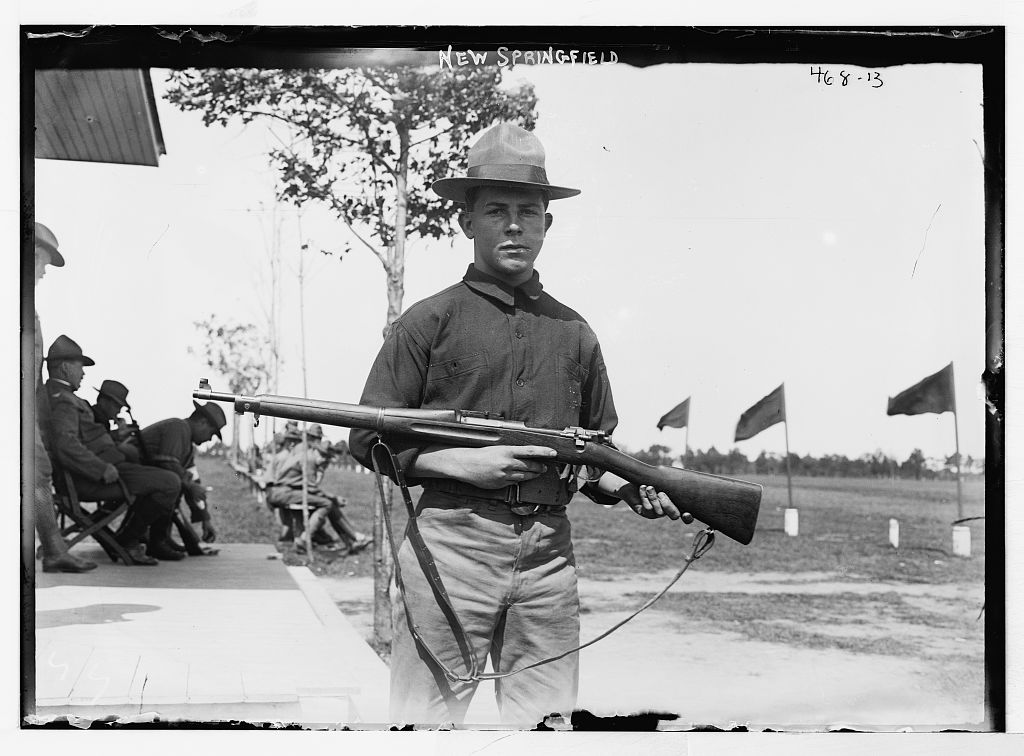
The M1903 Springfield was a staple of U.S. Army life for the first half of the 20th Century (Photo: Library of Congress)
Nonetheless, the ’03 Springfield, updated after 1906 with the new 30.06 round, became one of the most successful Army rifles in history– serving in one form or another as a front-line weapon through World War II. Heck, the U.S. military still has some around today, albeit not for combat use.
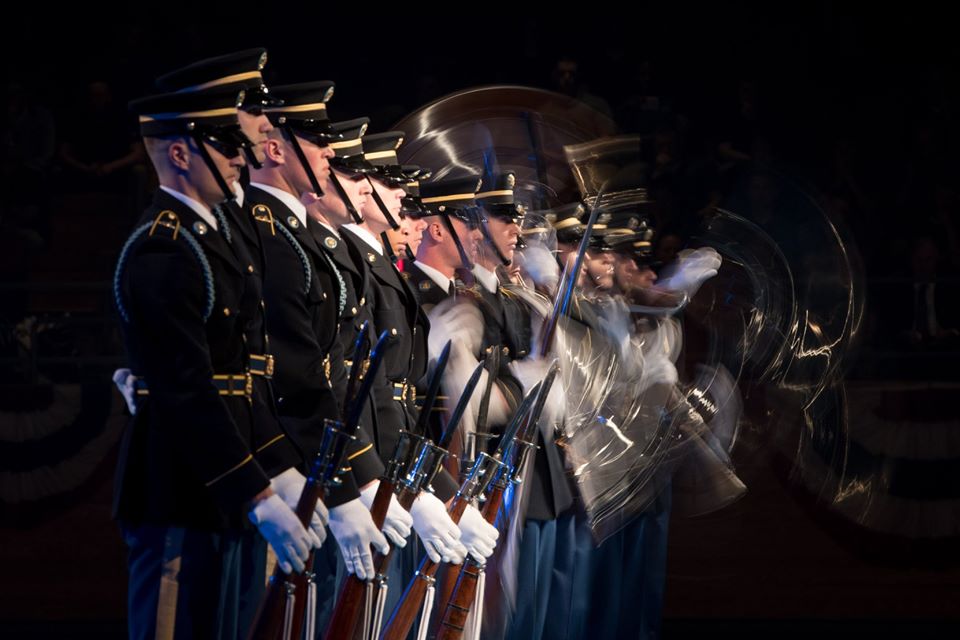
The U.S. Army Drill Team, seen here in 2019, still uses the M1903 Springfield, complete with bayonet. (Photo: U.S. Army)
To augment the M1903 when the U.S. Army grew rapidly from a handful of regulars to a multi-million-man force in the Great War, Uncle Sam took out contracts with Remington and Winchester to provide stocks of substitute M1917 rifles to the growing divisions of Doughboys headed “Over There” to fight the Kaiser.
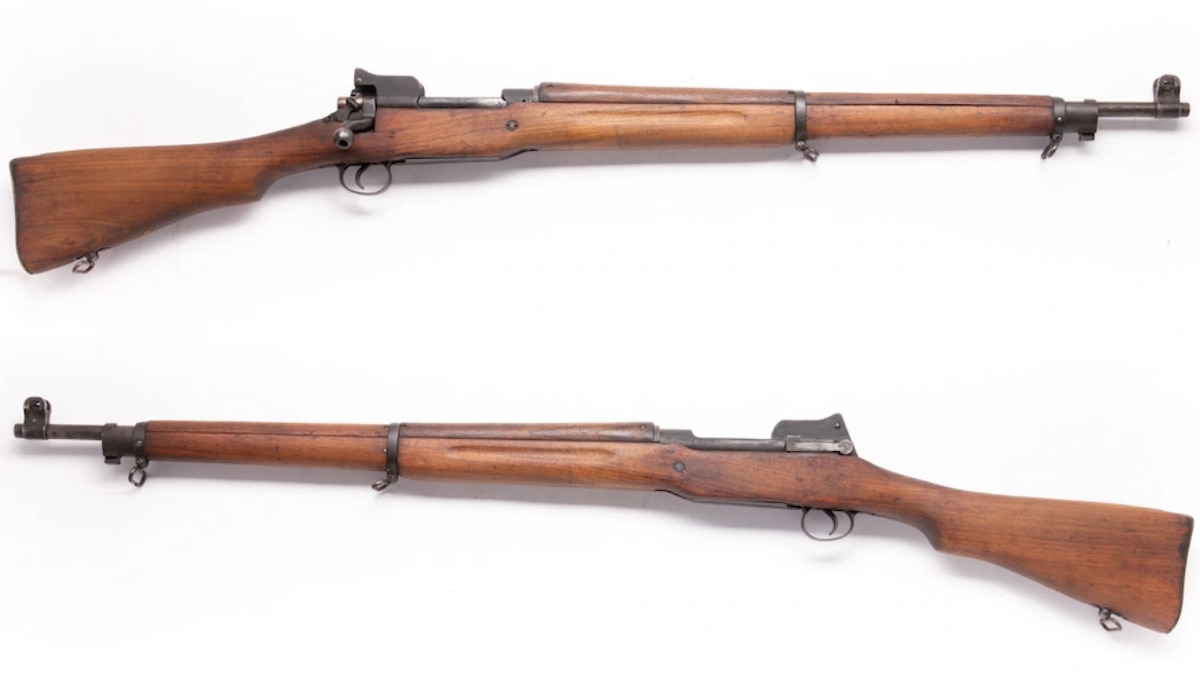
The M1917 was the British-contract Pattern 14 rifle, which had been made in the States for the King’s legions in the first few years of World War I, except chambered for the downright American .30-06 cartridge. (Photo: Guns.com)
By 1937, the Army was looking to innovate further and became one of the first militaries on the globe to adopt a semi-automatic rifle for their rank-and-file infantry, John Garand’s M1.
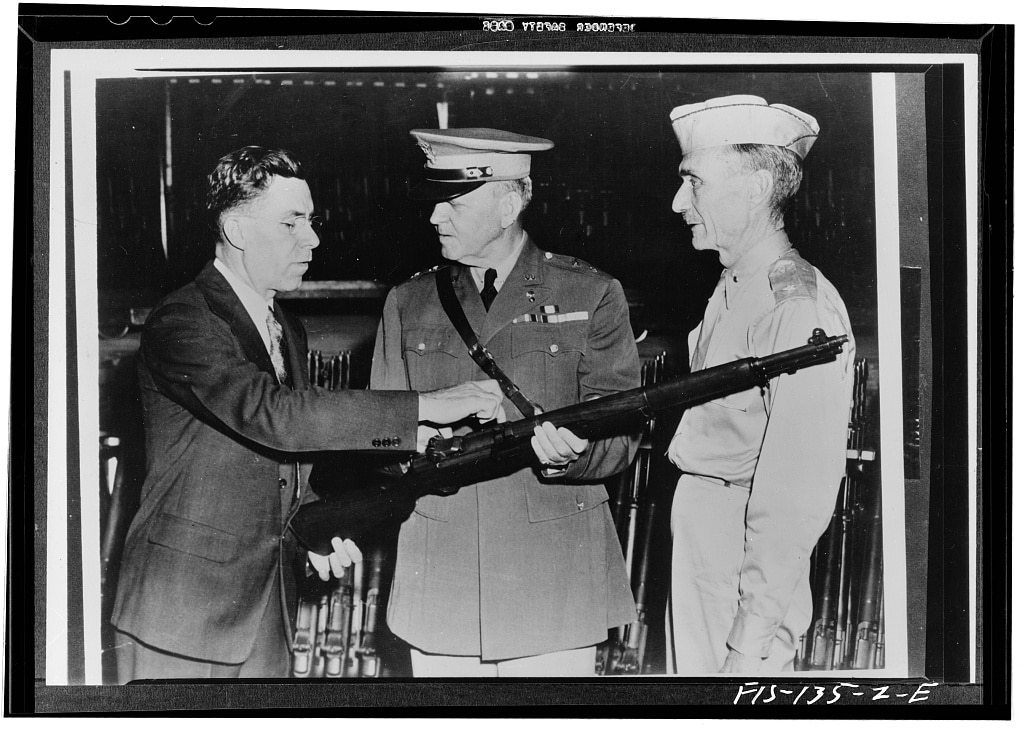
“Springfield, Massachusetts. John C. Garand, inventor of the Garand rifle, pointing out some of the features of the rifle to Major General Charles M. Wesson during the general’s visit to the Springfield arsenal. At right is Brigadier General Gilbert H. Stewart, commanding officer of the arsenal” (Photo & Caption: Library of Congress)
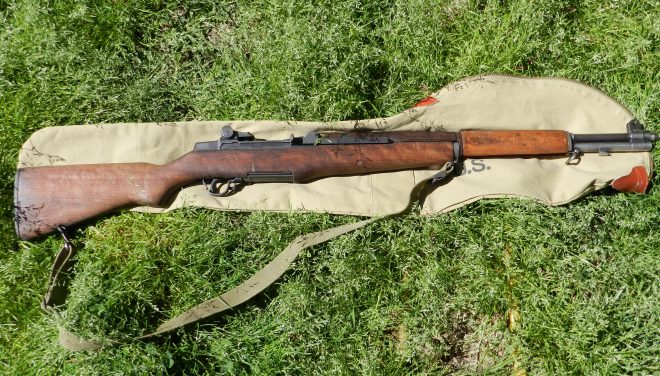
The 9.5-pound Garand, officially ” U.S. rifle, caliber .30, M1″ had a 24-inch barrel and wooden furniture. They cost the Army about $85 to produce during WWII and remained the standard American military rifle until the select-fire M14 came along in 1957. (Photo: Chris Eger/Guns.com)
However, as with the M1917 in WWI, the Army quickly ran short of M1s and tapped in an updated version of the M1903, classified as the M1903A3, to help close the gap.
The 8.7-pound M1903 was a bolt-action .30-06 fed by a 5-round stripper clip. It cost about $55 to make. Used by support units as well as for use as a sniper rifle and rifle grenade launcher in WWII, the ’03 remains in service with the military today as line throwers and drill rifles.
A more pint-sized weapon, the M1 Carbine, was a “war baby” of sorts, as it only reached production in 1942 as a compact rifle for use by support troops such as mortar crews, radiomen and truck drivers. Weighing in at just 5-pounds, the semi-auto used a detachable 15-round magazine and fired the 7.62x33mm .30 Carbine cartridge. In all, more than 5 million M1 Carbines were produced by companies as varied as Winchester, General Motor’s Inland Division, typewriter companies IBM and Underwood, National Postal Meter (guess what they made), and jukebox maker Rock-Ola.
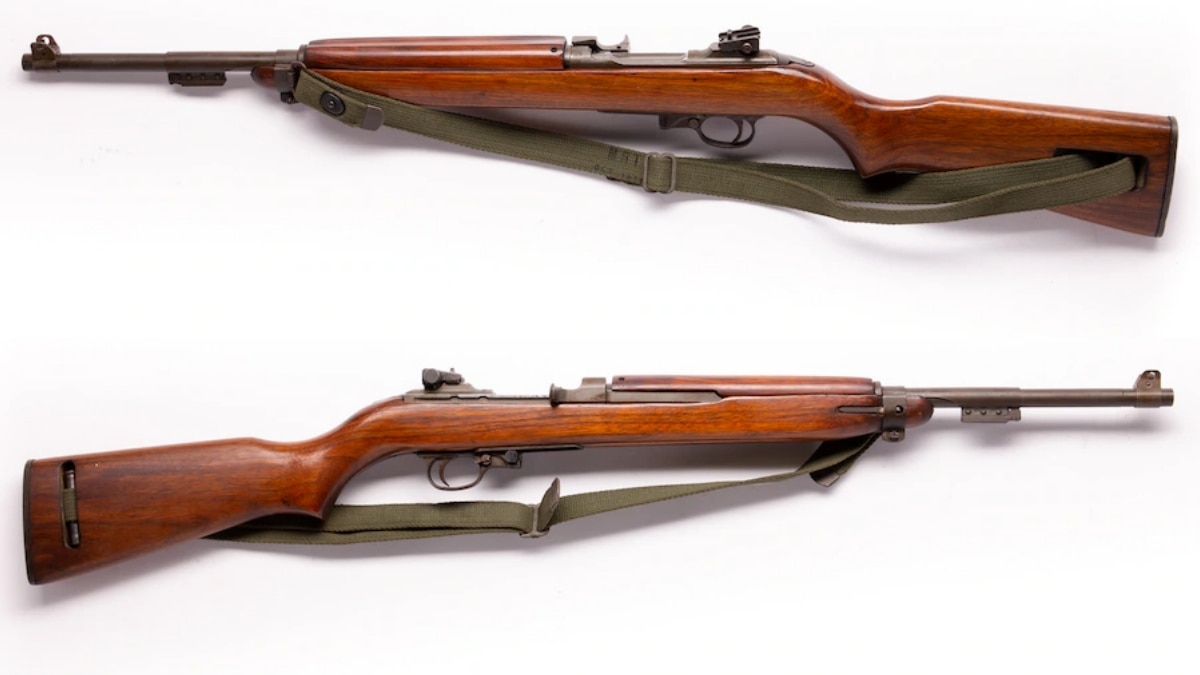
The M1 Carbine cost Uncle Sam $45 a pop to make during WWII, meaning about two of these compact light rifles could be bought for the price of each Garand. This Winchester-made example in the Guns.com Vault is a wartime-era carbine.
Added to this were millions of .45ACP-caliber submachine guns to include the M1928, M1 and M1A1 Thompson as well as the M-3 Grease Gun.
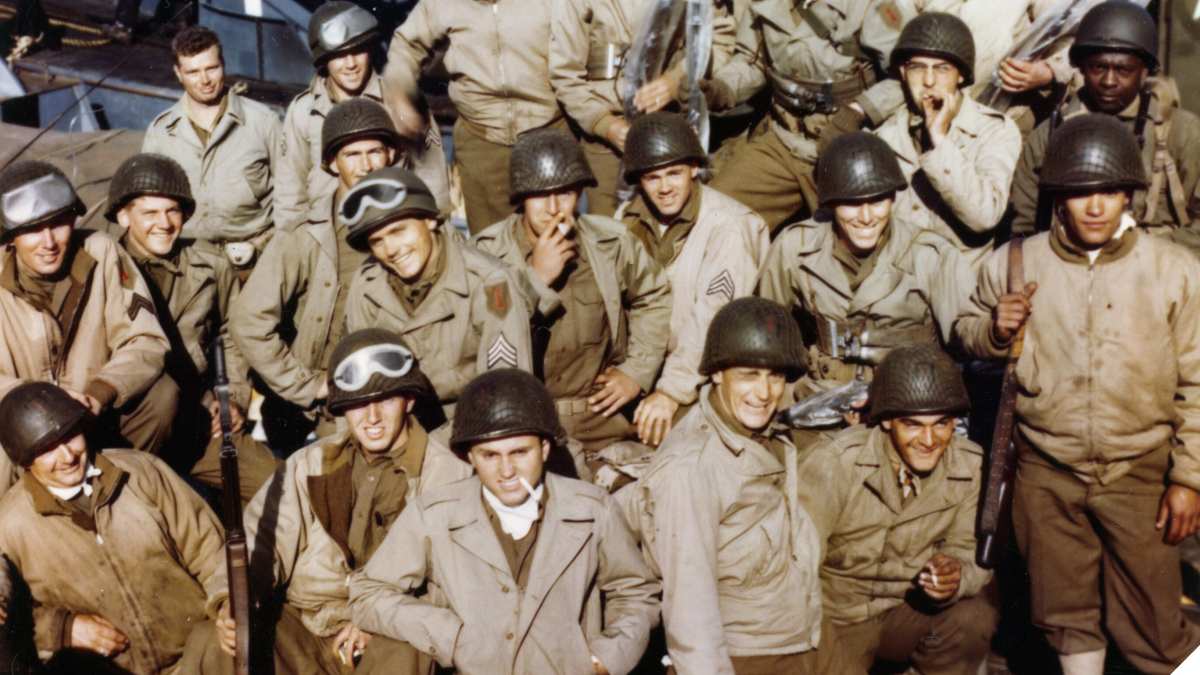
These soldiers of the U.S. Army’s 1st Infantry Division are embarking in England in June 1944. Destination: Omaha Beach (Photo: National Archives)
Then Came 1957
With the U.S. Army carrying the same guns from WWII into Korea and after, lessons learned from that conflict triggered a wave of change in the newly formed Pentagon. After a lengthy gestation period that saw numerous designs tested in several calibers and trials of foreign-made systems such as the FN FAL, the Army chose the Springfield Armory-developed M14 rifle to replace not only the M1 Garand and Carbine but also its sub guns and automatic rifles to a large extent.
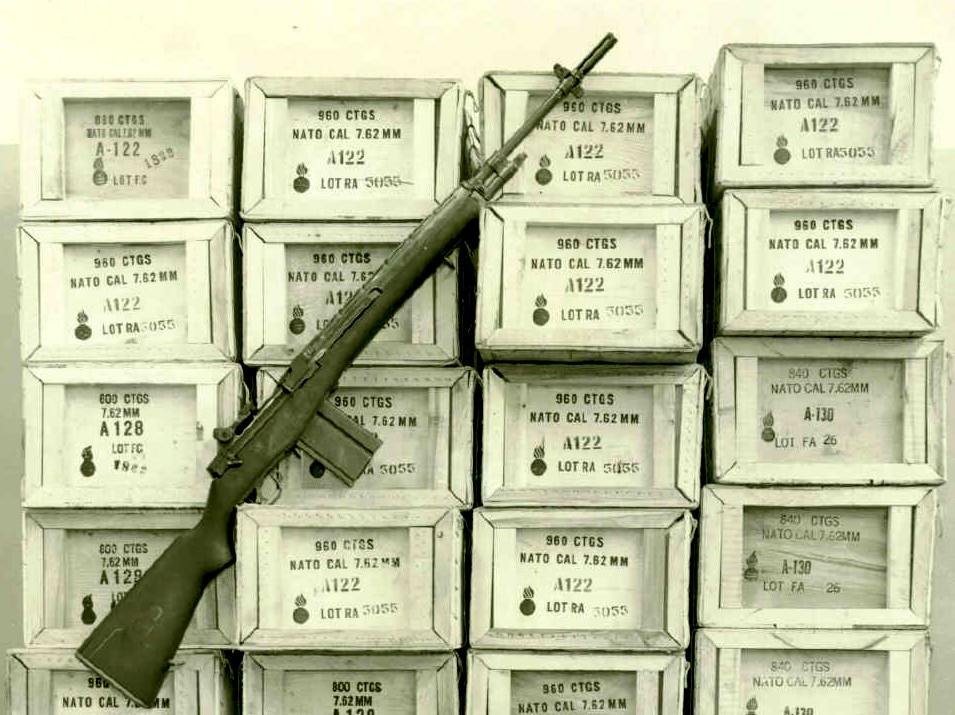
The M14 was the final rifle produced at the U.S. Army-run Springfield Armory (Photo: Springfield Armory National Historic Site)
The M14 had a lot of firsts for the U.S. military being the first time that every Soldier in a squad was issued a select-fire weapon– although most were later blocked from their full rock-and-roll setting– and the first chambered in 7.62 NATO. It also marked a lot of lasts for the Army, being the service’s last in-house developed rifle, the last to use wooden furniture, and the final rifle produced at Springfield Armory.
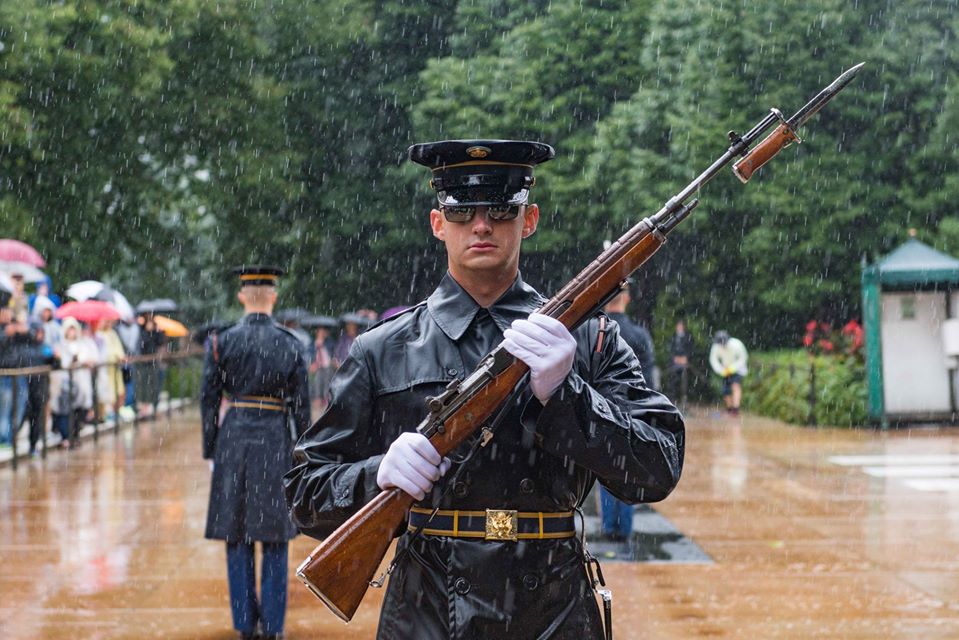
While largely replaced in the field after the 1960s by the M16-series, the Tomb Sentinels at Arlington National Cemetery, part of the U.S. Army’s Old Guard, still stand post 24/7/365 with M14s. (Photo: U.S. Army)
Armalite Endurance
By 1964, the Pentagon signaled that the way of the future was to be Colt’s AR-15 series platform, adopted as the M16. Chambered in 5.56 NATO, it was lighter than the M14 due to its more compact size and synthetic furniture, and its likewise smaller cartridge allowed troops in the field to carry more rounds per pound.
With that, by 1968 the M14 was out of production by the military and the M16 became the go-to rifle of American Soldiers and Marines in Vietnam and along the front lines of the Cold War.
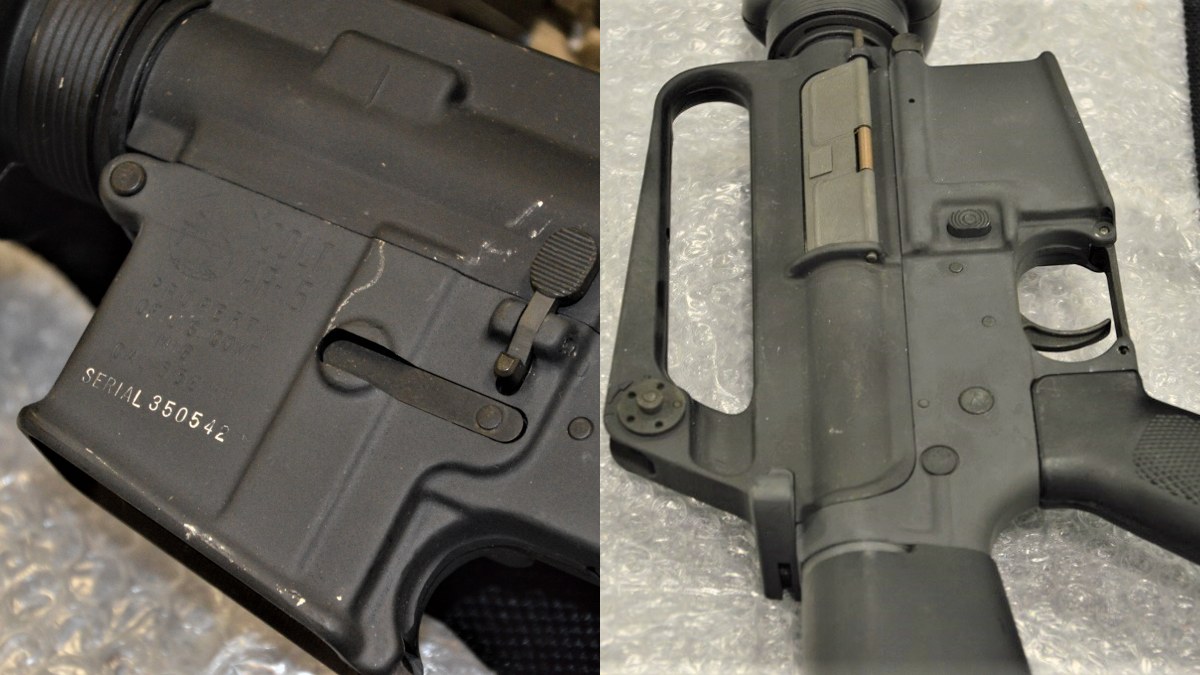
This early Colt-made AR-15-marked M16, with a three-pronged flash hider and no forward assist, is in the Army’s museum system, although not on display (Photo: Chris Eger/Guns.com)
Updated across several decades, the XM16E1, with an Army-requested forward assist and internal improvements, entered service, a standard that became the M16A1 after 1966.
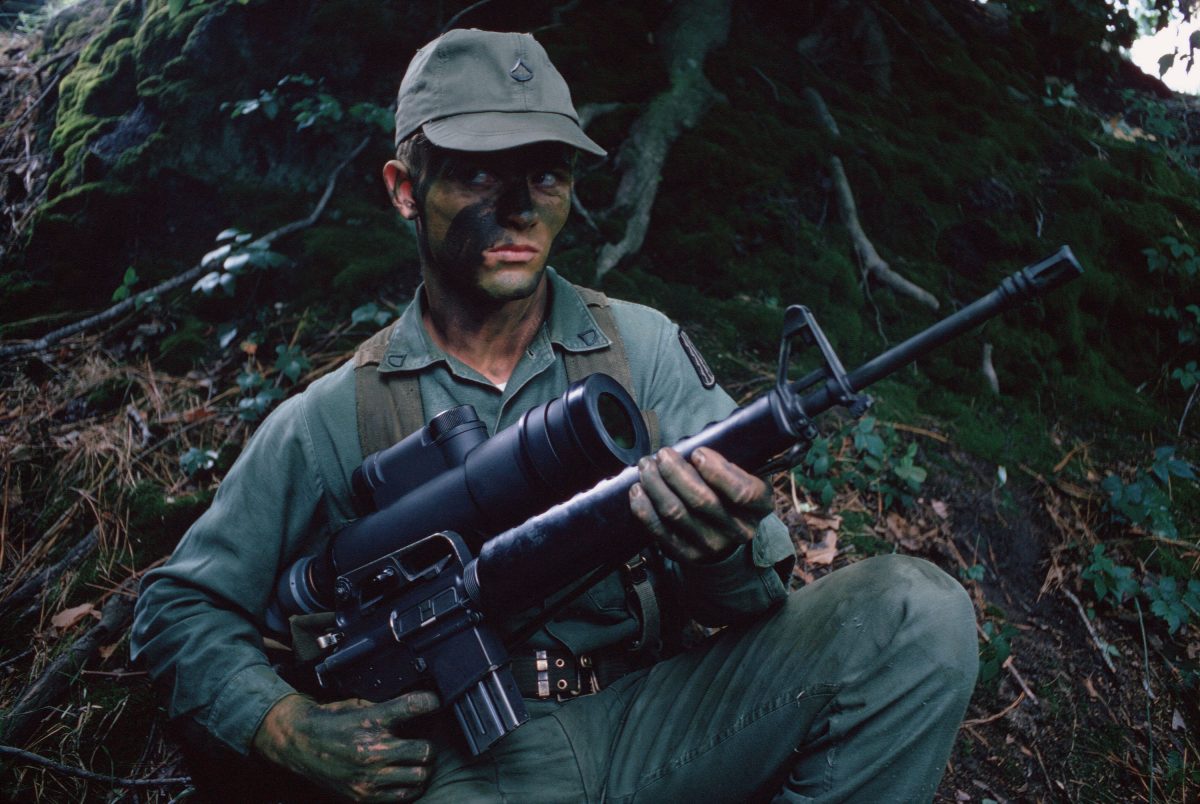
An infantryman armed with an M16A1 rifle and AN/PVS-2 Starlight scope for use at night, July 1, 1972 (Photo & Caption: National Archives)
In 1982, the rifle had been updated by Colt to have round handguards, a faster 1:7 twist rate, a three-round burst rather than a full-auto setting, and updated sights to become the M16A2.
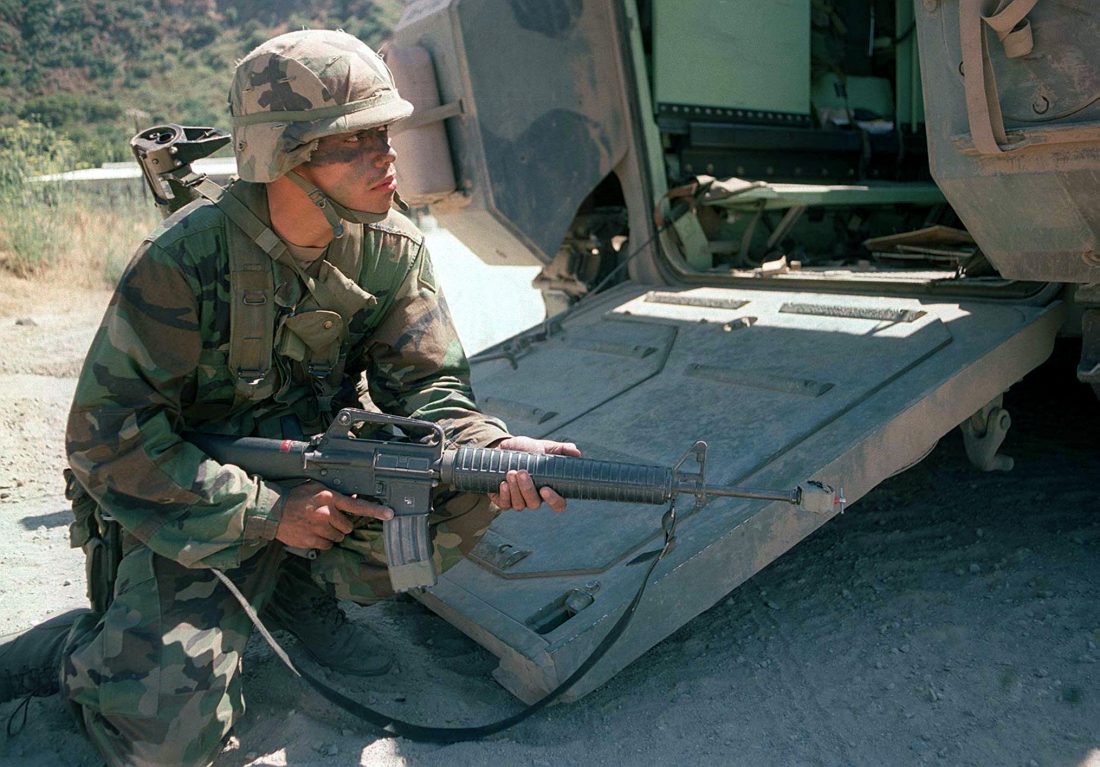
A soldier, armed with 5.56mm Colt M16A2, from the 3d Infantry Battalion, 160th Regiment, US Army National Guard, sets up a hasty defense after disembarking from a Bradley fighting vehicle during Military Operations in Urban Terrain (MOUT) operations, Exercise KERNEL BLITZ ’97, June 28, 1997. (Photo & Caption: National Archives)
The 1990s brought the M16A3, which went back to “auto” rather than the burst selector switch and the M16A4, a flat-top version adopted by the Marines with a removable carrying handle.
By 1994, the more compact M4 Carbine, essentially an update of the Vietnam-era XM177 carbine variant of the original M16A1, entered service. When it did, it replaced older M16s as well as remaining stocks of M3 Grease Guns and enduring XM177s, becoming the standard for U.S troops for the past two decades with active contracts still underway with companies such as FN and Colt to supply guns to not only our forces but to overseas allies.
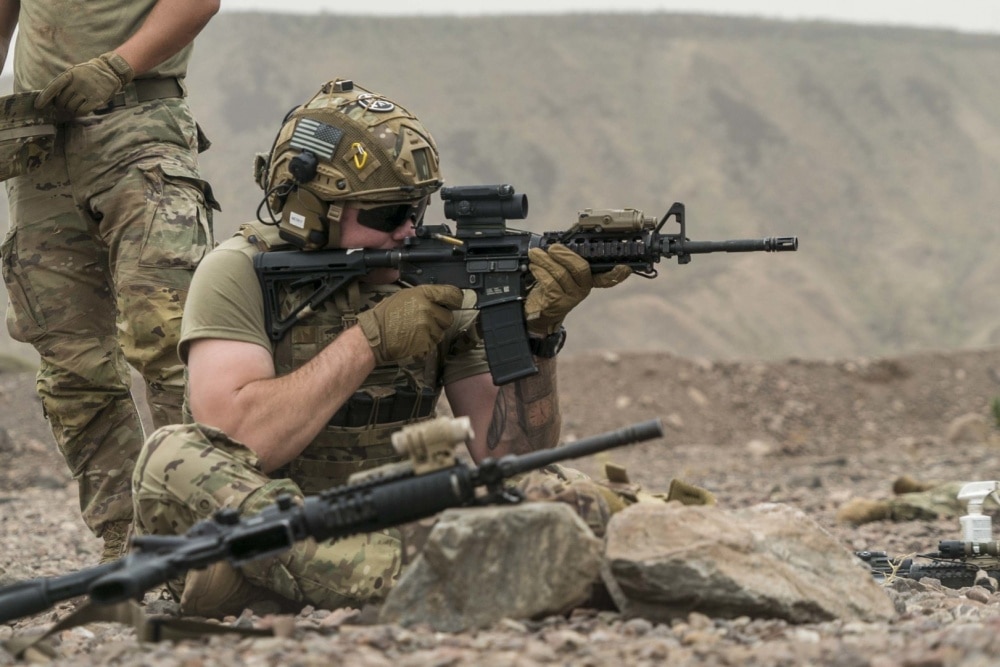
U.S. Army Spc. Cody Meracle, 1-186th Infantry Battalion, Site Security Team, Task Force Guardian infantryman, Combined Joint Task Force-Horn of Africa (CJTF-HOA), fires an M4 carbine at a firing range in Djibouti, June 13, 2020. (Photo & Caption: Department of Defense)
Tomorrow
Nonetheless, efforts are currently underway to phase out the M4 in use by the Army with a new series of modern small arms under the Next Generation Squad Weapon program. The Army plans to purchase 85,986 NGSW systems to replace guns in combat units first. Ultimately, the winner could stand to deliver 250,000 NGSWs and 150 million rounds of ammo plus options for further contracts.
Three consortiums have submitted designs to the Army for review under a 2019 award. The winners include AAI Corporation/Textron Systems in Hunt Valley, Maryland; General Dynamics-OTS Inc. in Williston, Vermont; and Sig Sauer in Newington, New Hampshire. A common theme among the submissions is a 6.8mm caliber, with at least two of the teams submitting hybrid bi-metallic or composite-cased ammunition which is both lighter and delivers better performance than 5.56 NATO rounds.
Sig’s entry, for reference, is detailed in the below video.
General Dynamics Ordnance & Tactical Systems, which is working with True Velocity and Beretta, have submitted heir new RM277 NGSW platform, a bullpup with lots of modularity. Notably, the gun uses True Velocity’s 6.8mm composite-cased cartridge, which has a “drastic reduction in cartridge weight and enhanced accuracy.”
Textron, which has subcontracted with ammo maker Winchester-Olin and firearms maker Heckler & Koch, has been a bit coyer on their submission to the NGSW program.
In the end, no matter what the Army goes with, the next rifle adopted will simply join a long line of those that preceded it, proving good company.
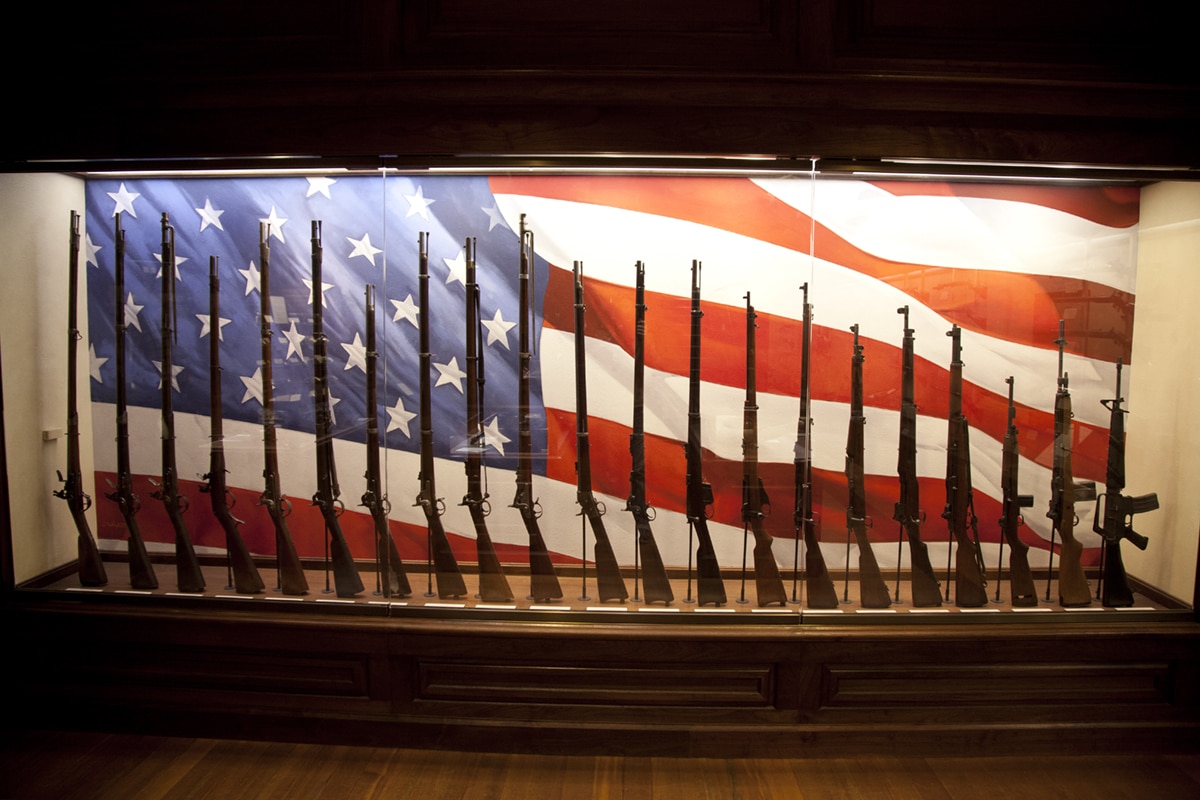
From wood to polymer, flintlocks to M4s. (Photo: Ben Philippi)
If you like interesting guns with a story to tell, head on over to our carefully curated selection of Military Classics, where history is just a click away.
The post Happy Independence Day: Guns of the Grunt 1776-2020 appeared first on Guns.com.
Powered by WPeMatico

